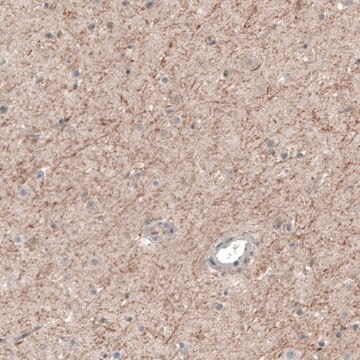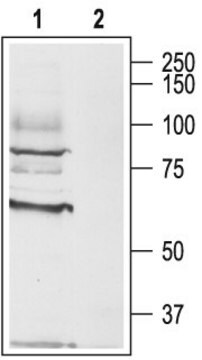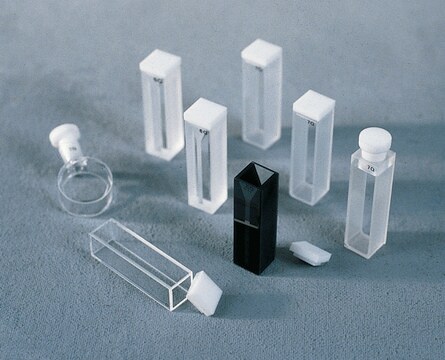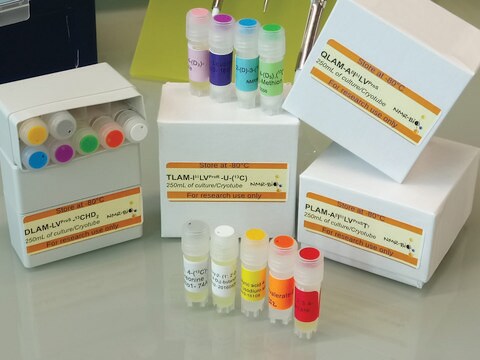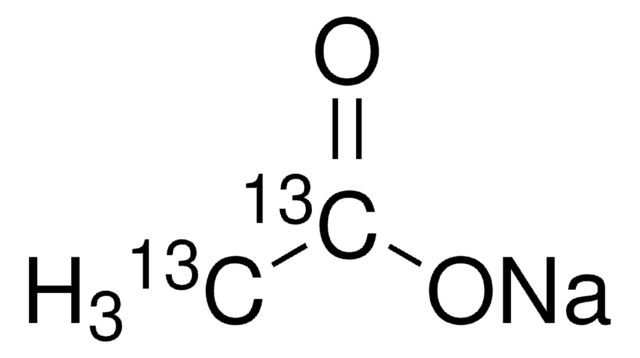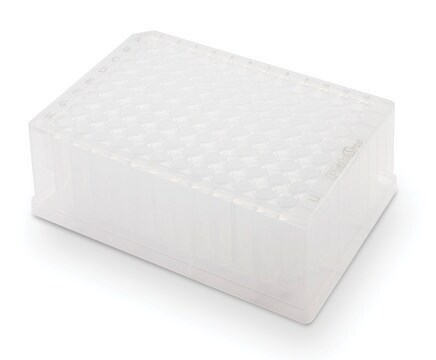推荐产品
生物源
rabbit
品質等級
抗體表格
affinity purified immunoglobulin
抗體產品種類
primary antibodies
無性繁殖
polyclonal
純化經由
affinity chromatography
物種活性
rat
製造商/商標名
Chemicon®
技術
western blot: suitable
NCBI登錄號
UniProt登錄號
運輸包裝
wet ice
目標翻譯後修改
unmodified
基因資訊
rat ... Chrm3(24260)
特異性
Muscarinic acetylcholine receptor m3.
免疫原
Synthetic peptide from the 3rd intracellular loop of rat m3 (Accession P08483). The immunogen sequence is identical in human, mouse, bovine and porcine.
應用
Research Category
Neuroscience
Neuroscience
Research Sub Category
Neurotransmitters & Receptors
Neurotransmitters & Receptors
This Anti-Muscarinic Acetylcholine Receptor m3 Antibody is validated for use in WB for the detection of Muscarinic Acetylcholine Receptor m3.
Western blot: 1:2000 using ECL on rat brain lysate.
Dilutions should be made using a carrier protein such as BSA (1-3%)
Optimal working dilutions must be determined by the end user.
SUGGESTED WESTERN BLOT PROTOCOL
1. Mix the samples (organ membranes: 50 μg/lane; transfected cells: 500,000 cells/lane) with sample-buffer X 2, and heat 10 min at 70°C.
2. 5-50 μL applied to Minigel lane (0.75-1.5 mm width) and run at standard conditions. (60 mA for 2 1.5 mm Minigel gels, 1.4 h). It is suggested that you run 5-15% acrylamide (37.5:1 acrylamide:bisacrysmide) minigel (1.5 mm width) at 30 mA/gel ~1-1.5 hours.
3. Transfer in semi-dry system under standard conditions (3 h 100 mA for two minigel gels)
4. Stain the transferred bands with Chemicon BLOT-FastStain (Catalog Number 2076).
5. Destain with deionized water.
6. Block with 5% non-fat milk (Marvel or Carnation) in PBS, and 0.025 % sodium azide, overnight at 2-8°C. The non-fat milk should be dissolved freshly, centrifuged 10,000 rpm for 10 min, and filtered through glass filter (Gelman Acrodisc).
7. Incubation with first antibody 2 h at room temperature or overnight at 4°C in blocking solution. The antibody preparation should be centrifuged before use (10,000 g 5 min.). Optimal working dilutions and incubation time will need to be determined by the end user.
8. Wash 4 x 10 min. with PBS-0.1% tween 20. From this stage, azide should be omitted.
9. Incubation with the secondary antibody (HRP-conjugated goat anti-rabbit antibody, for example Chemicon Catalog Number AP132P, diluted appropriately) 1 h at room temperature.
10. Wash 4 x 10 min. with PBS-0.1% tween 20.
11. Perform ECL with commercial kits (Chemilucent, Chemicon Catalog Number 2600).
Dilutions should be made using a carrier protein such as BSA (1-3%)
Optimal working dilutions must be determined by the end user.
SUGGESTED WESTERN BLOT PROTOCOL
1. Mix the samples (organ membranes: 50 μg/lane; transfected cells: 500,000 cells/lane) with sample-buffer X 2, and heat 10 min at 70°C.
2. 5-50 μL applied to Minigel lane (0.75-1.5 mm width) and run at standard conditions. (60 mA for 2 1.5 mm Minigel gels, 1.4 h). It is suggested that you run 5-15% acrylamide (37.5:1 acrylamide:bisacrysmide) minigel (1.5 mm width) at 30 mA/gel ~1-1.5 hours.
3. Transfer in semi-dry system under standard conditions (3 h 100 mA for two minigel gels)
4. Stain the transferred bands with Chemicon BLOT-FastStain (Catalog Number 2076).
5. Destain with deionized water.
6. Block with 5% non-fat milk (Marvel or Carnation) in PBS, and 0.025 % sodium azide, overnight at 2-8°C. The non-fat milk should be dissolved freshly, centrifuged 10,000 rpm for 10 min, and filtered through glass filter (Gelman Acrodisc).
7. Incubation with first antibody 2 h at room temperature or overnight at 4°C in blocking solution. The antibody preparation should be centrifuged before use (10,000 g 5 min.). Optimal working dilutions and incubation time will need to be determined by the end user.
8. Wash 4 x 10 min. with PBS-0.1% tween 20. From this stage, azide should be omitted.
9. Incubation with the secondary antibody (HRP-conjugated goat anti-rabbit antibody, for example Chemicon Catalog Number AP132P, diluted appropriately) 1 h at room temperature.
10. Wash 4 x 10 min. with PBS-0.1% tween 20.
11. Perform ECL with commercial kits (Chemilucent, Chemicon Catalog Number 2600).
外觀
Affinity purified immunoglobulin. Lyophilized from phosphate buffered saline, pH 7.4, containing 1% BSA, and 0.05% sodium azide as a preservative. Reconstitute with 50 μL of sterile deionized water. Centrifuge antibody preparation before use (10,000 xg for 5 min).
儲存和穩定性
Maintain lyophilized material at -20°C for up to 12 months after date of receipt. After reconstitution maintain at -20°C in undiluted aliquots for up to 6 months. Avoid repeated freeze/thaw cycles.
分析報告
Control
Included free of charge with the antibody is 40 μg of control antigen. The stock solution of the antigen can be made up using 100 μL of sterile distilled water. For negative control, preincubate 1 μg of peptide with 1 μg of antibody for one hour at room temperature. Optimal concentrations must be determined by the end user.
Included free of charge with the antibody is 40 μg of control antigen. The stock solution of the antigen can be made up using 100 μL of sterile distilled water. For negative control, preincubate 1 μg of peptide with 1 μg of antibody for one hour at room temperature. Optimal concentrations must be determined by the end user.
其他說明
Concentration: Please refer to the Certificate of Analysis for the lot-specific concentration.
法律資訊
CHEMICON is a registered trademark of Merck KGaA, Darmstadt, Germany
免責聲明
Unless otherwise stated in our catalog or other company documentation accompanying the product(s), our products are intended for research use only and are not to be used for any other purpose, which includes but is not limited to, unauthorized commercial uses, in vitro diagnostic uses, ex vivo or in vivo therapeutic uses or any type of consumption or application to humans or animals.
未找到合适的产品?
试试我们的产品选型工具.
Marcy L Guerra et al.
The Journal of biological chemistry, 289(20), 14370-14379 (2014-04-04)
We have shown recently that the class C G protein-coupled receptor T1R1/T1R3 taste receptor complex is an early amino acid sensor in MIN6 pancreatic β cells. Amino acids are unable to activate ERK1/2 in β cells in which T1R3 has
Michael Winder et al.
Basic & clinical pharmacology & toxicology, 121(4), 257-265 (2017-04-25)
In the urinary bladder, the main source of NO seems to be the urothelium and the underlying suburothelium. In this study, we aimed to characterize how receptors in the human urothelium regulate the production and release of NO. For this
Masato Asahina et al.
Internal medicine (Tokyo, Japan), 52(24), 2733-2737 (2013-12-18)
The autoimmune mechanism is considered to play an important role in the development of acquired idiopathic generalized anhidrosis (AIGA), and muscarinic M3 receptors (M3Rs) on eccrine glands are possible autoimmune targets. We investigated the existence of autoantibodies against M3Rs in
我们的科学家团队拥有各种研究领域经验,包括生命科学、材料科学、化学合成、色谱、分析及许多其他领域.
联系技术服务部门